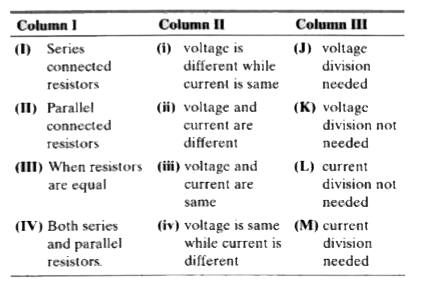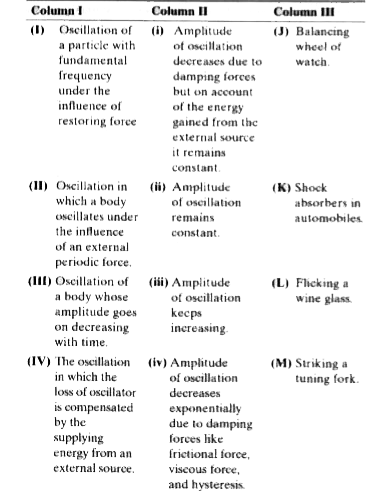In the given table , the column shown the lower fixed point (LEP), Column II shows the upper fixed point (UFP) and the Column III gives corresponding division on the scale for three different scales for temperature measurement .

Determine the features of Rankine scale.
(I) (ii) (K)
(IV) (iii) (J)
(II) (iii) (M)
(I) (iii) (J)
The correct Answer is:A, D
Step by step video & image solution for In the given table , the column shown the lower fixed point (LEP), Column II shows the upper fixed point (UFP) and the Column III gives corresponding division on the scale for three different scales for temperature measurement . Determine the features of Rankine scale. by Physics experts to help you in doubts & scoring excellent marks in Class 12 exams.
Updated on:21/07/2023Topper's Solved these Questions
- TEMPERATURE, ZEROTH LAW OF THERMODYNAMICS AND THERMAL EXPANSION BOOK - RESNICK AND HALLIDAYCHAPTER - TEMPERATURE, ZEROTH LAW OF THERMODYNAMICS AND THERMAL EXPANSION EXERCISE - PRACTICE QUETIONS (Integer Type)
4 Videos
- TEMPERATURE, ZEROTH LAW OF THERMODYNAMICS AND THERMAL EXPANSION BOOK - RESNICK AND HALLIDAYCHAPTER - TEMPERATURE, ZEROTH LAW OF THERMODYNAMICS AND THERMAL EXPANSION EXERCISE - PRACTICE QUETIONS (More than One Correct Choice Type )
7 Videos
- RIGID BODY DYNAMICS-IIBOOK - RESNICK AND HALLIDAYCHAPTER - RIGID BODY DYNAMICS-IIEXERCISE - PRACTICE QUESTIONS (Integer Type)
2 Videos
- THE FIRST LAW OF THERMODYNAMICSBOOK - RESNICK AND HALLIDAYCHAPTER - THE FIRST LAW OF THERMODYNAMICSEXERCISE - PRACTICE QUESTIONS ( INTEGER TYPE )
3 Videos
Similar Questions
In the given table , the column shown the lower fixed point (LEP), Column II shows the upper fixed point (UFP) and the Column III gives corresponding division on the scale for three different scales for temperature measurement .

Determine the features of Fahrenheit scale.
View SolutionIn the given table , the column shown the lower fixed point (LEP), Column II shows the upper fixed point (UFP) and the Column III gives corresponding division on the scale for three different scales for temperature measurement .

Determine of features of Reaumer scale
View Solution
Knowledge Check
In the given table, Column I gives frequencies of different waves, Column II gives their examples and Column III gives their graphical representation.

What are the characteristics of infrasonic waves?A(II) (i) (K)B(I) (i) (L)C(III) (iii) (J)D(I) (iv) (L)Electrical current is the flow of charged particles. The electric current flows through a wire the same way as how water moves in a river. The electricity is nothing but the flow of electrons. There are two main combinations of resistors in circuit, that is series and parallel. In the given table, Column I shows different combinations of resistors, Column II shows voltages of different arrangements of resistors and Column III shows currents and voltage division needed or not in different arrangements of resistors.

When there is no voltage division problem arise?A(II) (iv) (K)B(IV) (i) (M)C(III) (ii) (L)D(III) (iv) (K)In the given table, Column I gives frequencies of different waves, Column II gives their examples and Column III gives their graphical representation.

What are the characteristics of ultrasonic waves?A(IV) (ii) (M)B(I) (iii) (L)C(II) (iv) (L)D(III) (ii) (M)
In the given table, Column I gives type of oscillation, Column II gives change in amplitude of oscillation and Column III gives examples of these types of oscillation.

The combination that defines the features of damped oscillation is
View SolutionIn the given table, Column I gives frequencies of different waves, Column II gives their examples and Column III gives their graphical representation.

What are the characteristics of auible waves?
View SolutionElectrical current is the flow of charged particles. The electric current flows through a wire the same way as how water moves in a river. The electricity is nothing but the flow of electrons. There are two main combinations of resistors in circuit, that is series and parallel. In the given table, Column I shows different combinations of resistors, Column II shows voltages of different arrangements of resistors and Column III shows currents and voltage division needed or not in different arrangements of resistors.

When does the current division problem arise?
View SolutionElectrical current is the flow of charged particles. The electric current flows through a wire the same way as how water moves in a river. The electricity is nothing but the flow of electrons. There are two main combinations of resistors in circuit, that is series and parallel. In the given table, Column I shows different combinations of resistors, Column II shows voltages of different arrangements of resistors and Column III shows currents and voltage division needed or not in different arrangements of resistors.

When does the voltage division problem arise?
View SolutionThere are different types of radioactive series that radioactivie decay follows. In the given table, Column I shows the end or stable nuclei which any one of the radioactive series produces, Column II shows the mass number of different tpes of ratioactive series and Column III shows different values of n different radioactive sereis.

Determine the characteristics of actinium.
View Solution
